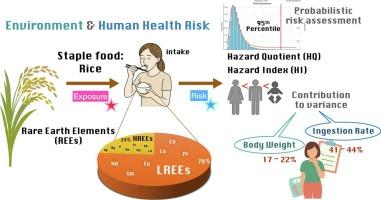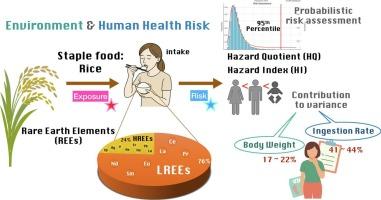Probabilistic health risk assessment of rare earth elements through rice (Oryza sativa L.) consumption using Monte Carlo simulation
IF 9.8
1区 农林科学
Q1 CHEMISTRY, APPLIED
引用次数: 0
Abstract
Rice is a major dietary staple and an important pathway for exposure to rare earth elements (REEs), which are environment-borne contaminants. In this study, 265 rice samples from Taiwan were analyzed, and dietary exposure to 15 REEs was assessed using Monte Carlo simulation. Mean concentrations followed the order Ce > La > Y > Nd, with light REEs accounting for 77 %. Although heavy REEs were less abundant, they contributed proportionally higher non-carcinogenic risks. The mean estimated daily intake (0.012 μg kg−1 bw−1) and the 95th percentile (0.043 μg kg−1 bw−1) were both far below a commonly cited reference value of 70 μg kg−1 bw−1, indicating minimal risk. The highest exposures were observed in children aged 0–3 years, reflecting lower body weight and higher ingestion rates. Sensitivity analysis identified ingestion rate as the most influential factor, followed by body weight and the concentrations of Y, Ce, Eu, and La.


基于蒙特卡罗模拟的水稻(Oryza sativa L.)食用稀土元素健康风险概率评估
水稻是人类主要的膳食主食,也是人类接触环境污染物稀土元素的重要途径。本研究以台湾265份稻米样本为研究对象,利用蒙特卡洛模拟方法评估15种稀土元素的膳食暴露量。平均浓度顺序为Ce >; La > Y > Nd,轻稀土占77%。虽然重稀土元素含量较低,但它们的非致癌风险比例较高。平均估计日摄入量(0.012 μg kg−1 bw−1)和第95百分位(0.043 μg kg−1 bw−1)都远低于常用的参考值70 μg kg−1 bw−1,表明风险最小。在0-3岁的儿童中观察到最高的暴露,反映出较低的体重和较高的摄入率。敏感性分析发现,摄食率是最重要的影响因素,其次是体重和Y、Ce、Eu和La浓度。
本文章由计算机程序翻译,如有差异,请以英文原文为准。
求助全文
约1分钟内获得全文
求助全文
来源期刊

Food Chemistry
工程技术-食品科技
CiteScore
16.30
自引率
10.20%
发文量
3130
审稿时长
122 days
期刊介绍:
Food Chemistry publishes original research papers dealing with the advancement of the chemistry and biochemistry of foods or the analytical methods/ approach used. All papers should focus on the novelty of the research carried out.
 求助内容:
求助内容: 应助结果提醒方式:
应助结果提醒方式:


